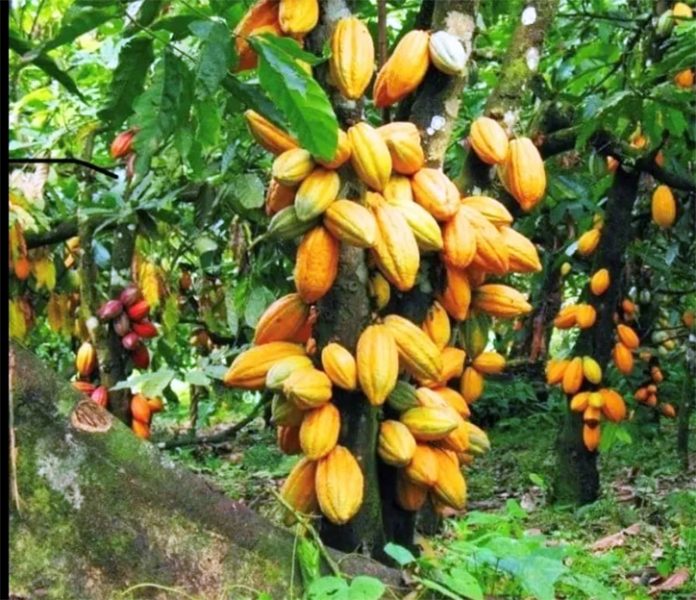It is impossible to imagine Ghana without cocoa. With an experimental first export of some forty pounds of cocoa in the late 1880s, Ghana (then the Gold Coast) rose to become the world’s leading exporter of cocoa in 1911 with an export of 40,356 tons. The country dominated global cocoa production until it was displaced to number two by Côte d’Ivoire in the late 1970s. Currently, Ghana and Côte d’Ivoire together produce about 60% of the world’s cocoa.
Cocoa has shaped our political economy, animated our politics, and built our physical infrastructure such as dams, ports, and roads. The product has also educated thousands of Ghanaians through Cocoa Marketing Board scholarships. Cocoa farms have become heirlooms passed down within families, and though we may not be a chocolate-consuming nation, cocoa is very much in our blood.
Today, the cocoa industry in Ghana faces an existential threat and we are in danger of losing the crop that has defined our economy, social and cultural lives for more than a century. Climate change has ushered in a period of aridity or less rainfall in the West African forest belt.
This has affected lands eligible for cocoa production and reduced cocoa yields, as rainfall is crucial to the budding of cocoa pods and the soil’s capacity to absorb fertilizer. It is estimated that land suitable for cocoa cultivation in Ghana has declined from 2 million hectares to 1.3 million hectares. Cocoa is a crop grown mainly by smallholders all over the world.
West Africa produces some 70% of global cocoa, but the world price for cocoa is determined in London and New York, and not in Accra or Abidjan. From the 1950s when nationalist governments assumed the control of cocoa marketing boards, the crop has become the engine of economic development. It is not surprising that in Ghana, cocoa became known as “the golden pod.”
Cocoa birthed a huge state infrastructure that oversees the production, quality control, transport, and export of the crop. This state infrastructure, importantly, includes a research unit (Cocoa Research Institute of Ghana) that conducts high-level scientific research to ensure the sustainability of cocoa.
Cocoa was the leading source of foreign exchange for Ghana until the 1990s when it was overtaken by mineral exports. Generally, the world price for Ghana’s cocoa is divided in three ways: roughly about 60% goes to the farmer, 20% goes to COCOBOD (the former Cocoa Marketing Board), and about 20% goes to the government. The cumbersome infrastructure that pays cocoa farmers means that payment for their crop can be unduly delayed.
As far back as the colonial period, cocoa farmers have been plagued by debt. Their demands for financial assistance underpinned the formation of the first state-owned bank in 1953, the Bank of the Gold Coast, now GCB Bank. Cocoa farmers have cut down their trees to grow food crops or rubber. Our cocoa trees are old, our soils are exhausted, our cocoa farmers are getting older.
In Ghana and Côte d’Ivoire, the younger generation have not taken up the cocoa farms of their parents or been attracted to cocoa farming. It is not surprising that the elderly, often indebted cocoa farmers are selling their farms to artisanal gold miners or those involved in illegal mining referred to as galamsey.
I encountered the threat of artisanal gold mining to the cocoa industry in 2013 in Amansie West in the Ashanti Region, when I led a field research team to investigate the presence of Chinese entrepreneurs in the artisanal goldmining industry.
I learned to my surprise that the Ghana Minerals Commission does not survey the land before it awards an artisanal mining license. The artisanal miner armed with his license goes to the land, which is covered by cocoa or oil palm and is faced with the challenge of compensating the farmer before he can remove the tree cover to mine. The initial turn to the Chinese for partnerships was because these license holders lacked capital. Ironically, the two leading sources of government revenue, cocoa and gold, have been brought into contention.
The advent of community mining may even have intensified this competition, as in the southern part of Ghana auriferous and cocoa-growing land overlap. The result is the environmental destruction of farmland and the massive pollution of water bodies. The Belgian-Ghanaian journalist, Joel Savage, has recently pointed to how artisanal gold mining is rendering Ghanaian cocoa dangerous for consumption.
He notes that: “The European Union currently views Ghanaian cocoa as dangerous for consumption due to environmental risks …” (Joel Savage, “The Ghanaian Government must stop all illegal mining,” Modern Ghana, April 9, 2024). If unchecked, our cocoa will be banned from entry into the European Union.
The above-listed factors came together to create a market panic earlier this year. In late March 2024, cocoa prices on the world market topped $10,000 a ton in New York, double the price from just two months before in January 2024. The cause was much lower cocoa “yields” than expected in Côte d’Ivoire and Ghana for the main cocoa crop season between October and March.
A Financial Times story (Susanah Savage, March 25, 2024) pointed to weather and disease as the two main culprits behind the low yields. A report by Reuters around the same time highlighted additional troubling factors that threatened cocoa production in Ghana: demoralized underpaid farmers, old trees, exhausted soils, and the menace of illegal gold mining (Reuters, March 27, 2024). The Reuters story observed that market analysts predict that Ecuador will overtake Ghana as the second-leading producer of cocoa by 2027.
So, what should we do to save our cocoa industry? I end with some suggestions towards a solution. First, government policy should resolve the contention between cocoa and gold mining. Second, we should change the Western narrative that has West Africa producing cocoa for the West. Western writers often cite how 95% of West African cocoa farmers have never tasted chocolate.
It gives the impression that if we do not sell our cocoa to the West, we have no use for it. The global chocolate market was valued in 2022 at $121.10 billion. In comparison, cocoa beans traded in 2022 totaled $8.29 billion or about 6.8% of the chocolate market. However, there are uses of cocoa other than chocolate.
For Professor Douglas Boateng, an expert in commodity supply and value chains, the future of cocoa in Ghana must include nutraceuticals (the area of nutrition and pharmaceuticals). He stresses the nutritional and medicinal benefits of cocoa for high blood pressure, insomnia, skincare, eczema, alopecia, and others. As a country, we must invest in research and development (R&D) in cocoa products.
Chocolate producers like Cadbury and Mars have invested in scientific research to ensure the sustainability of the cocoa industry. What is the Government of Ghana doing? R & D is beyond the Ghanaian private sector. Ghana and Malaysia achieved independence in the same year with a comparable GDP. In the early 1960s, Malaysia came to West Africa to borrow palm oil seedlings and to set up an exchange program with West African countries to diversify its dependence on tin and rubber.
Through scientific research, Malaysia pushed its cultivation and use of palm oil to another level. Today Indonesia and Malaysia are the two leading producers of palm oil in the world, an industry estimated at $60 billion in February 2020. Third, there are several chocolatiers in Ghana (and Côte d’Ivoire) producing top-quality craft chocolate. How do we support them? Craft chocolate is about making chocolate with a story that goes from bean to bar.
This requires that chocolatiers have access to cocoa farmers and encourage the growing of premium beans through price incentives. The current system under COCOBOD makes this impossible. With the recent formation of the African Continental Free Trade Area (AfCFTA), we have potentially an unlimited market for our cocoa products.
Is the present structure of COCOBOD and its relationship to the government ideal for pursuing these objectives? Officials in Ghana and the Conseil du Café-Cacao (CCC) in Côte d’Ivoire are both convinced that they have the best systems.
Côte d’Ivoire has liberalized the cocoa industry. COCOBOD has liberalized the internal purchasing and transport of cocoa, but all beans purchased end up with COCOBOD, the sole exporter and internal marketer of Ghana’s beans. COCOBOD’s quality control has ensured Ghana’s reputation as the best producer of “bulk” beans in the world. However, COCOBOD is saddled each year with raising money on international markets to buy Ghana’s entire cocoa crop. The present unpredictable yields, this has made the annual financing of cocoa more challenging.
As the sole buyer and exporter of Ghana’s cocoa, the regulator of the cocoa industry, and a profit-making organization that is also dedicated to the welfare of the cocoa farmer and the sustainability of the industry, COCOBOD is a bundle of contradictions. Clearly, COCOBOD’s infrastructure needs to be interrogated, and a system put in place that prioritizes Ghana’s cocoa farmers. Or we may not have cocoa around for much longer.
By: Emmanuel Kwaku Akyeampong
Source: citinewsroom.com









